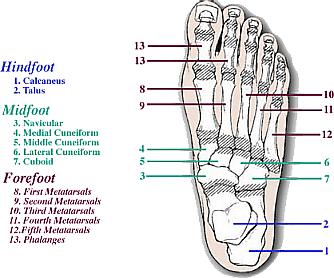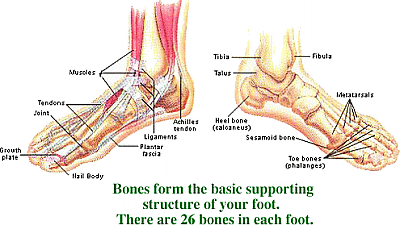

Reflexology – History & Modern Uses by [irulan]
Need to relax. Well, who doesn't? In this stress-filled world, everyone needs to relax. A way in which one can do this is reflexology. And just what exactly is that you may ask? Reflexology is an ancient healing art based on the principle that there are reflexes in the hands, feet, and ears that correspond to every part, gland, and organ of the body. Through application of pressure on these reflexes, reflexology relieves tension, improves circulation, and promotes the natural function of the related areas of the body.
History
Reflexology is a healing art which has traveled through time from the distant past; it has been known to man for many thousands of years. In most ancient cultures there is actually a tradition of working on the feet to help the body balance itself. The most concrete evidence of this practice in ancient culture was the discovery of a wall painting depicting the practice of hand and foot reflexology in the tomb of Amkhmahor (highest official after the Pharaoh) at Saqqara; it is also known as the physician's tomb. This Egyptian wall painting is dated at the 6th Dynasty, about 2330 BCE. Prior to this discovery it was widely believed that reflexology had ancient origins and frequent conjecture was made about its relationship to and development alongside the ancient Oriental practices of shiatsu and acupuncture. Similarly, Native American medicine men are believed to manipulate and stimulate the feet as a part of their healing practice.
The scientific basis to reflexology begins in the last couple of centuries. In the 1890's knighted research scientist and medical doctor, Sir Henry Head, demonstrated the neurological relationship that exists between the skin and internal organs. Nobel Prize winner Sir Charles Sherrington proved that the whole nervous system and body adjusts to a stimulus when it is applied to any part of the body. The Russians, beginning with Drs Ivan Pavlov and Vladimir Bekhterev have also been exploring reflex responses in the body for nearly a century.
These ideas were built upon and researched and from them modern reflexology emerged. It is based primarily on the work of an American physician – Dr. William Fitzgerald. Fitzgerald discovered that pressure, when applied to certain points on the body could relieve pain and improve the functions of certain organs of the body. He also developed a new system of ten equal vertical zones from the top of the head to the tips of the toes and hands. He concluded that pressure on one part of a zone could affect everything else within that zone. Thus, reflex areas on the feet and hands are linked to other areas and organs of the body within the same zone. Physiotherapist Eunice Ingram also played a big part in the development of reflexology as we know it. She worked Dr. Fitzgerald's knowledge into a usable therapy calling it Foot Reflexology and took it to the public into the late 1930's into the early 1970s. As a result of her promoting public awareness, more practicing reflexologists have emerged, more than 30 books have been published, and the number of magazine articles has increased significantly over the past 20 years.
Modern Uses
In ancient times, we stimulated reflexes naturally by walking barefoot over rocks, stones, and other rough ground, or by using our hands more often to climb, build, or work. In today's modern world we have lost much of nature's way of maintaining a balanced and healthy equilibrium. Reflexology helps to restore this balance and promote natural health and vitality. The therapy brings relief to a wide range of conditions and is suitable for all ages.
It is primarily an exercise in relaxation. Relaxing is important to our vital health. It is an acknowledged fact by the medical community that a body trying to function while under the influence of prolonged stress is less capable of organizing its defenses against illness and repair damage caused by injury. Reflexology can negate the effects of stress while it helps the body relax. It gently nudges the body towards better functioning by improving lymphatic drainage and venous circulation, simulation to the nerve pathways and muscle relaxation. It simply stimulates the body's natural healing mechanisms to normalize and heal.
What can you expect if you decide to try reflexology? You will have a preliminary talk with the practitioner. The reflexologist will then begin to work on your feet, or hands if necessary, noting problem areas. You may experience discomfort, but it is fleeting and is an indication of congestion or imbalance in a corresponding part of the body. Sensitive, trained hands can detect tiny deposits and imbalances in the feet and by working on these points, the reflexologist can release blockages and restore the free flow of energy to the whole body. Typically, a treatment session last for about an hour. In my area the cost was about $50-65 for one hour of treatment. Once your body is tuned up, it is recommended to have regular treatments in order to help maintain health and well-being.
Recent research studies have been conducted around the world which are validating the effectiveness of reflexology on a wide variety of conditions. Chronic conditions seem to respond especially well to reflexology. In China, where reflexology is accepted by the central government as a means of preventing and curing diseases and preserving health, over 300 research studies have shown reflexology provided some improvement to 95% of the over 18,000 cases covering 64 illnesses studied. In Japan and Denmark, reflexology has been incorporated into the employee health programs of several large corporations saving each company thousands of dollars annually in paid out sick leave benefits. Although reflexology does not diagnose or treat specific ailments by definition, it has proven highly successful over time to relieve symptoms or ease pain or discomfort that have manifested themselves physically in the body, either as a result of stress, trauma, or disease.
Reflexology has stood the test of time – it has been used for many thousands of years. And though it has anecdotally been found to have a positive effect on the body suffering from a wide variety of chronic problems, it is most certainly not a panacea for all ills. It is not a substitute for medical treatment, but rather a complement to any type of medical approach or therapy. Reflexology can also be incorporated into an overall healthy lifestyle which includes attention to diet, moderate exercise, and different forms of stress reduction and relaxation.
For further information please visit http://www.reflexology.org and http://www.reflexologyusa.org

Foot Facts
Did you know the foot is made up of…
̶ 26 bones
̶ 18 muscles
̶ 106 ligaments
̶ 30 tendons
̶ 33 joints
̶ 3 arches
̶ 5 nerves
̶ Thick fibrous tissue to support the arches
̶ A pad of fat undeneath the skin that acts as a cushion
̶ yards & yards of blood and lymphatic vessels

Images provided by [The Seventh Nazgûl]
The Dangers of Laughter
Seeing that this month's theme is jesters, I've decided to go beyond medically oriented articles and be a bit more jestive myself, so here's the outcome of some observations on laughter, and though it may be the best medicine, too much of a good thing is bad enough. Ladies and gentlemen, the dangers of laughter. It should be noted that this has been greatly simplified for the non-medical readers, and though it contains an extent of realistic facts, it has been only made as a fun article for a special theme, and should therefore be considered jestive.
Laughs are classified, according to intensity and duration into 4 grades; I, II, III, and IV.
Let's start with an overview of what occurs during a grade I laugh.
This sequence of events represents a "laugh" cycle.
1- Muscles in the face contract, producing the characteristic facial expression(s) of laughter.
2- The first stage of laughter involves an exhalation, followed by an immediate inhalation whose force depends on the intensity of the exhalation.
3- A cough could occur with some subjects, and then a deep breath.
This is a short-lived, grade I laugh. They usually do not involve many cycles and are of a rather short duration. The eyes are either open or closed, depending on the subject's predisposition to laughter.
The more advanced stage of laughter is grade II. Grade II laughs occur in case of prolonged jestogenic (laughter-inducing) stimuli to the person's nervous system. They are, of course, of longer duration than grade I laughs and are of greater intensity.
Events during grade II laughs include
- The facial muscles and diaphragm contract more forcibly
- The eyes are often closed
- The initial exhalation is accompanied by the laugh sound, the following exhalation is rather forceful
4- A series of 2-3 laugh cycles (or even longer) usually occurs
5- The face may redden, and in some cases, a mild headache and/or a little lacrimation (tear secretion) may follow
6- The person's sides and anterior abdominal wall (front) will hurt a bit due to the movement of the body's muscles attributed to the laugh
7- The person may be out-of-breath for a while
Moving on to a more serious stage, grade III. These are severe cases and are usually out of control. Easily detectable according to the following criteria:
- They usually topple over with laughter
- The laugh may be accompanied by or replaced with a grunt
- Laugh cycles are often 5 or above
- The exhalation, laugh sound, and inhalation are very loud and prominent
- The cough is rather loud, if present
- The face will probably redden and the headache and/or lacrimation could be annoying, even painful.
- The muscle movements, and therefore pains experienced in grade II will be of greater intensity.
Emergency condition laughter, grade IV. It could be fatal if left untreated.
- The laugher is on the ground, banging it with fists, or slapping him/herself.
- There is no exhalatalion, inhalation or sound, voiceless demented laughter reigns supreme
- There is profuse lacrimation, and a horrible headache
- Much of the earlier manifestations is present, but at a greater intensity than before
The laugher will laugh on and on and on, and if he/she does not stop, then death by laughter is the inevitable outcome due to halted heart, brain, and lung functions.
So a word of advice, laugh, for laughter is a very very beneficial thing, but stick to grades I and II, ok.
Again, I say that this article has only been posted in the Herald for the purpose of entertaining.